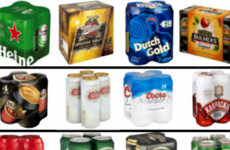

- Australia's largest state hits record-high COVID-19 cases despite weeks of strict lockdown. 'It's a tinderbox ready to explode,' one official said.
- eToro says crypto made up 73% of trading commissions in the last quarter, as retail customers dived in
- A flight attendant says she was too exhausted to report a passenger who shoved her when a flight was overbooked: report
- US jobless claims climb for first time in 5 weeks, to 353,000
IT IS SIMPLY taken as fact that swimming after eating will cause you to cramp up and drown. And everyone knows that sitting too close to the TV ruins your eyesight.
Superstitious in nature, old wives’ tales like these get passed down through generations of family and friends, sometimes becoming so rooted that nobody questions their validity. These legends, which often concern health and nutrition, vary from completely absurd to somewhat plausible. Here are five old wives’ tales and the truths behind them.
Swimming less than an hour after you eat causes cramps and leads to drowning.
Most children have probably heard from their parents that they must wait at least an hour after eating before hopping into the water for a swim. Otherwise, they could suffer cramps and drown. The theory behind this tale is actually pretty sound and has to do with a shift in blood flow in the body.
When you eat something, your body increases the blood flow to your stomach muscles to help with digestion. The larger the meal you scarf down, the more oxygenated blood your stomach needs for digestion. But this means less oxygen available for your arms and legs, which require an increased amount during exercise (whether you’re swimming, running, or cycling). Depriving your muscles of vital oxygen can lead to cramps, conceivably increasing your risk of drowning.
For recreational swimmers, the risk of getting cramps after eating is actually very low; your body has more than enough oxygen to share between your stomach and limbs. The real danger lies with those who eat huge meals before vigorous, triathlon-level exercise. Such cases can indeed lead to cramps and even vomiting. But even then, the medical consensus has long been that it’s unlikely to result in drowning; that is, unless the swimmer all-out panics and forgets how to float.
Spicy food causes ulcers.
For decades, doctors thought eating a lot of spicy food caused stomach ulcers, or painful sores on the lining of the esophagus, stomach or upper area of the small intestine. It certainly made sense, as patients would often complain of burning stomach pains after eating spicy food. The treatment: a strict diet of bland food (which didn’t actually get rid of the ulcer pain).
But in the 1980s, scientists put this old wives’ tale to rest (at least in the medical community — a lot of people still believe this one). Studies showed that spicy food doesn’t cause ulcers, though it can irritate existing ulcers, which explains the misunderstanding. [Can Eating Too Much Spicy Food Kill You?]
The real culprit behind the majority of ulcers, researchers found, was the bacterium Helicobacter pylori. When H. pylori enters the body, it heads for the stomach, excreting protective enzymes to shield it from the stomach’s harmful digestive acids. H. pylori then burrows into the stomach’s mucosal lining, which partially protects it from white blood cells, the immune system’s main weapon against bacterial intruders. Ulcers then develop as the bacteria colonise the stomach.
Today’s ulcer treatments usually involve antibiotics to kill the infection, but recent research has shown that cranberry juice may be effective, too. Interestingly, cranberry juice has long been a part of another popular — and possibly true — tale asserting that the tart drink effectively fights bladder infections. The mechanism behind both treatments is thought to be the same: Compounds in cranberry juice prevent bacteria from adhering to the cells lining the urinary tract and prevent H. pylori from sticking to the lining of the stomach.
Gum stays in your intestines for seven years.
Maybe you couldn’t find a nearby rubbish bin, or perhaps you were enjoying the taste just a little too much. Whatever the case, you did what most of us have done at one point or another: You swallowed your chewing gum. And if one old wives’ tale is true, that gum will be with you, in your digestive system, for the next seven years, wreaking who knows what kind of havoc.
Thankfully the legend is false.
As gastroenterologist Dr Rodger Liddle of the Duke University School of Medicine explained to Scientific American: “Nothing would reside that long unless it was so large it couldn’t get out of the stomach or it was trapped in the intestine.” [15 Weird Things Humans Do Every Day, and Why]
Chewing gum passes through the digestive system like any other food. Your body is able to break down some of the gum’s components, such as sweeteners and oil derivatives, but the gum’s rubber or latex base gets churned out in a matter of days.
However, this doesn’t mean you should start swallowing your chewing gum regularly — in several reported cases, doctors had to remove taffylike wads of gum from children’s bowels. Swallowing a lot of chewing gum in a relatively short amount of time, it seems, can cause the pieces to accumulate and stuff up the digestive tract, causing constipation.
Eating chocolate causes bad acne.
Though it may be your taste buds’ best friend, chocolate is your skin’s worst enemy, or so one decades-old tale claims. But is there any evidence behind chocolate’s supposed pimple-producing powers?
In 1969, research published in the Journal of the American Medical Association found that chocolate doesn’t worsen acne, and several subsequent studies have backed up that conclusion. Now both the American Academy of Dermatology and the National Institute of Arthritis and Musculoskeletal and Skin Disease say there’s no connection between chocolate and acne. In fact, the organisations assert that your diet, in general, has little effect on pimple development.
Still, recent research shows the issue isn’t so clear-cut. Last year a study published in the journal Clinics in Dermatology concluded the 1969 study was flawed in several ways, while a study published in Journal of the American Academy of Dermatology found a link between pure chocolate and pimple formation.
Despite the new findings, the major medical associations aren’t ready to change their rulings just yet. As usual, more research is needed.
Sitting too close to the television ruins your eyesight.
“Don’t sit too close to the TV or you’ll ruin your eyesight!” was once uttered by concerned parents around the world. And at one point in time, it actually may have been true.
The myth got its start in the late 1960s, when General Electric sold television sets that emitted levels of radiation as much as 100,000 times more than what federal health experts considered safe. To its credit, GE quickly recalled and repaired its hazardous TVs.
But there was a danger even before GE’s big blunder. Televisions developed before the 1950s emitted levels of radiation that could heighten a person’s risk of eye problems after repeated and extended exposure, Dr. Norman Saffra, chairman of ophthalmology at Maimonides Medical Center in Brooklyn, told the New York Times. [5 Everyday Things that Are Radioactive]
These issues are now a thing of past; modern TVs come with proper shielding to block radiation. Nowadays, the only eye problems that televisions cause are strain and fatigue, both of which can be cured by simply resting your eyes. The same goes for another popular old wives’ tale about reading in dim light.
Check out Life’s Little Mysteries for the real stories behind five more old wives’ tales.
Follow Life’s Little Mysteries on Twitter @llmysteries. We’re also on Facebook & Google+.









COMMENTS (34)